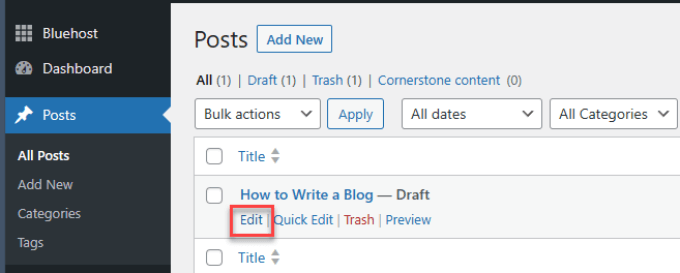Are you looking to add emojis to your SEO title in WordPress?
Boosting the click-through rates (CTR) on your blog posts can make a huge impact on your traffic and your bottom line. Emojis are visually appealing and help your page stand out.
In this post, we will show you how to add emojis to your SEO title in WordPress so you can stand out in search results and bring more traffic to your website.

Why Add Emojis to Your SEO Titles?
Emojis are small digital icons used to communicate emotions, objects, activities, and other concepts. They can either replace text or enhance the message, giving it more meaning.
On a page filled with words, colorful and bright emojis help your page stand out.
By using emojis, you draw attention to your page and make your brand seem more human, attracting your target audience and boosting click-through rates.
While increasing your CTR isn’t guaranteed to help you rank better on Google, getting more traffic to your website is always a good thing.
That’s not the only reason. Search engines also support search queries with emojis. Try typing ‘🍕recipe’ into the search bar of Google.

You’ll find a few search results with the ‘🍕’ emoji as Google likes to either find the best pizza recipe pages or pages with the exact ‘🍕’ emoji.
How to Use Emojis in Your SEO Titles
Emojis can negatively impact your click-through rates and SEO if they are seen as misleading or spammy.
Before you start embedding emojis all over your titles, there are some ground rules to follow:
- Consider your audience: Without a doubt, emojis work better for some niches than others. For example, including emojis on a recipe page for the best cocktails to make in the summer might be appropriate. But adding a heart or syringe to a page related to health care may hurt your brand’s reputation.
- Don’t use emojis to replace words: It doesn’t matter how clear or descriptive your emojis are. They should never replace words because users are forced to interpret the meaning of the emoji instead of being told.
- Use clear emojis: Avoid ambiguous emojis that people can misinterpret. Instead, stick to simple ones that are widely known to all audiences.
- Use emojis that work on both light and dark backgrounds: Don’t use light emojis on a light background. For example, a yellow hand emoji works better on light backgrounds than a white hand emoji. This is especially important for SEO titles since Google’s default results background is plain white.
Now that you know how to use emojis responsibly, you are ready to begin using them on your web pages.
Let’s take a look at how you can add emojis to your SEO titles.
How to Add Emojis to Your SEO Titles
Adding emojis to your titles is incredibly easy once you have a good plugin. Without it, you’d have to scour the internet to find the right emoji code, which overcomplicates the process.
The first step to adding emojis to your SEO titles is using the free All in One SEO plugin.
AIOSEO offers on-page analysis so you can optimize your blogs to rank higher in search results. You can also use the built-in emoji picker to add emojis to your SEO titles.
AIOSEO also comes with an SEO checklist tool, a link assistant, and many other features you can use to optimize your website to boost your rankings.
Start by installing the AIOSEO plugin. For more details, you can follow our step-by-step guide on how to install a WordPress plugin.
Once that’s done, you are ready to edit your blog posts and pages and add emojis to your SEO title.
Edit Your SEO Title
Optimizing your metadata is super simple with the AIOSEO plugin. In the left-hand menu of the WordPress admin dashboard, select Posts.
You can also do this for pages on your WordPress blog, but for this tutorial, we are just going to edit a post as an example.
Find the blog post you’d like to update. Then click the ‘Edit’ link. If you have both the Block and Classic editors enabled, then either will work.

Simply scroll down the WordPress content editor until you get to the ‘AIOSEO Settings’ tab.
From there, you can edit the post title field.

Choose Your Emoji and Add It
Now, you are ready to add your emoji to your metadata. To do that, scroll down a little further below the AIOSEO Settings.
Under Post Title, click on the emoji icon next to the tags in each field.

It’ll open up a window with a selection of emojis for you to choose from.
Browse through and pick the emoji of your choice, or just use the search bar to find what you are looking for.

Lastly, make sure to hit ‘Update/Publish’.
After that, the emoji will appear in the SEO title and display in search results.

Now, select your emoji of choice, and that’s it! Congratulations, you’ve just added emojis to your SEO title!
Frequently Asked Questions
Now that you know how to add emojis to your SEO titles, you may have a few more questions about how to effectively use emoticons to enhance your WordPress website.
How Do You Add Emojis to HTML Titles?
To add emojis to HTML titles, you can use the Unicode character codes for emojis directly within the title tag. You can find these codes on various websites that provide emoji Unicode references. Look for the emoji you want to use and then copy its Unicode code.
Inside the <title> tag, you can include the Unicode character code for the emoji. You must use the code &#x followed by the emoji code. For example, to add a smiley face emoji (😊) with the Unicode code U+1F60A, you would use 😊.
Do Emojis Affect SEO?
Google says you can use emojis in your SEO pages, including titles, but it won’t help or harm your search rankings in any way. However, emojis indirectly help your SEO efforts by improving click-through rates.
Emojis can humanize your brand, and if users spend more time on your site or interact with your content, these signals could boost your search ranking position.
Do Emojis Go Before or After Your Title?
Most emojis should generally come after text and never before. You want people to get the message first. Using emojis before the title can give a bad user experience, especially for anyone using a screen reader.
We hope this article has helped you learn how to add emojis to your WordPress SEO titles. You may also want to read our ultimate WordPress SEO guide for beginners and the most useful WordPress plugins for all websites.
If you liked this article, then please subscribe to our YouTube Channel for WordPress video tutorials. You can also find us on Twitter and Facebook.
Source: WPBeginner
